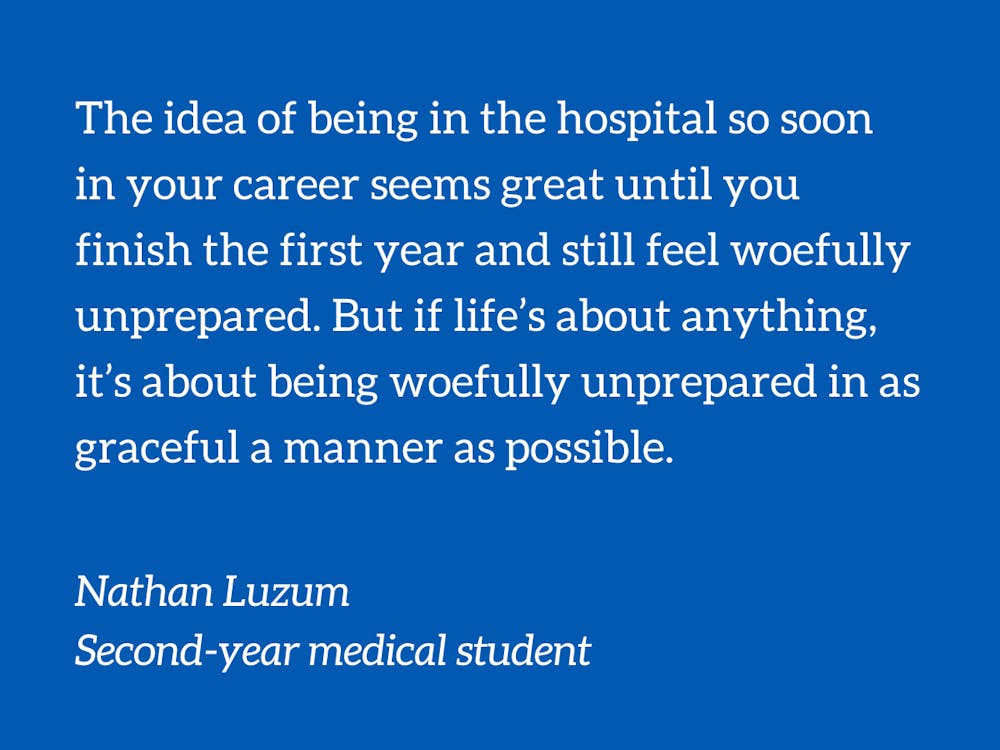To say the second year of medical school is an adjustment from the first is an understatement. From books to wards, from flexible days to regimented routine, the transformation is stark.
Duke is somewhat special in this regard. Many medical schools wait until the third year to throw their students onto the wards, allowing for two years of classroom learning to soak in and percolate. But Duke, in a pattern that many of its peer institutions have followed, began sending second-year students into the hospital for clerkships decades ago. Honestly, it’s one of the main reasons I applied here. Sitting in a classroom and listening to people drone on about the cell cycle? No thanks. Saving lives, delivering babies, chiming in with an obscure diagnosis that turns out to be right? Sign me up.
But all of those conjured images that proved so alluring while submitting applications can clash with the jarring transition between the first two years. The idea of being in the hospital so soon in your career seems great until you finish the first year and still feel woefully unprepared. But if life’s about anything, it’s about being woefully unprepared in as graceful a manner as possible.
So this was the attitude I had entering my first rotation, surgery. Surgery is notorious for its early mornings and long hours, requiring a 4:00 a.m. alarm many days to head in with time to change into the trademark surgical green scrubs.
As a morning person, I find it charming in a way to watch the world wake up. Strolling down a deserted Erwin Road after reading an article about a jogger in Memphis who was kidnapped on an early morning run, I sometimes wonder whether I should have purchased a parking pass. But these worries melt away as I’m greeted by the warm glow of the lights of Erwin’s most bitter rivals, the ExxonMobil and BP gas stations abutting the Research Drive intersection. On particularly lucky days, sometimes the gas prices will be different. This is an intriguing rarity to me, and I make sure to take a picture to document what feels like a forbidden peek behind the curtain.
Finally, I get to the hospital. There usually isn’t much activity at 5 a.m., but within the hour, the halls are abuzz as the day shift starts arriving and the night teams prepare to leave. As we finish rounding, a glimpse outside sometimes reveals the sun cresting the horizon; other times, darkness persists. In the hustle and bustle of the day, sometimes it can be easy to lose track of time and forget there’s a whole world outside.
The hospital itself is like a culture of its own, with new customs to learn. There’s an electronic medical record system to master technologically, a whole new smorgasbord of abbreviations and jargon to adopt, and routines to follow.
When you know nothing, it’s often tempting to pretend that you know everything. Walking into an operating room and admitting that you’ve never scrubbed in before seems embarrassing, but if my first couple weeks on the wards have taught me anything, it’s that most people love the feeling of being helpful. There’s no need to pretend to know how to do something and make a mistake, I’ve learned, especially when there are plenty of people who have done that very same thing thousands of times surrounding you. Balancing the humility of seeking help and the confidence in one’s own knowledge to forge ahead without assistance seems to be one of the most important aspects of medicine.
Being a second-year medical student in the hospital also makes you constantly aware that you’re at the bottom of the food chain. Behind this cadre composed of attending physicians, fellows, senior residents, interns and fourth-year medical students is you, dutifully following orders and attempting to chip in when you can. This knowledge comes with the realization that you’ve worked many years to get where you are, but still have many left to go.
Watching a surgeon and other more senior members of the team deftly maneuver instruments during an operation can make you question how much value you really add. A second-year medical student’s job during surgery generally involves manning the camera, holding the retractors to help the surgeon see the area in which they’re operating or helping suture incisions at the end of an operation.
What I’ve begun to realize is that the role of a medical student on the team—at least on the surgery rotation—isn’t so much technical as it is humanizing. Students aren’t going to singlehandedly perform a life-saving operation, but we are the ones with the most time to actually interact with patients when other team members are bogged down with other tasks. We serve as fresh faces to push the more senior practitioners to rethink an assumption or remind them of their younger selves. And it’s a privilege to occupy that role.
Nathan Luzum is a second-year medical student and a member of the DSPC Board of Directors. His column runs on alternate Wednesdays.
Get The Chronicle straight to your inbox
Signup for our weekly newsletter. Cancel at any time.

